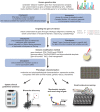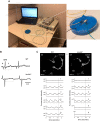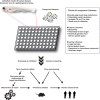LITTLE FISH, BIG DATA: ZEBRAFISH AS A MODEL FOR CARDIOVASCULAR AND METABOLIC DISEASE
- PMID: 28468832
- PMCID: PMC5817164
- DOI: 10.1152/physrev.00038.2016
LITTLE FISH, BIG DATA: ZEBRAFISH AS A MODEL FOR CARDIOVASCULAR AND METABOLIC DISEASE
Abstract
The burden of cardiovascular and metabolic diseases worldwide is staggering. The emergence of systems approaches in biology promises new therapies, faster and cheaper diagnostics, and personalized medicine. However, a profound understanding of pathogenic mechanisms at the cellular and molecular levels remains a fundamental requirement for discovery and therapeutics. Animal models of human disease are cornerstones of drug discovery as they allow identification of novel pharmacological targets by linking gene function with pathogenesis. The zebrafish model has been used for decades to study development and pathophysiology. More than ever, the specific strengths of the zebrafish model make it a prime partner in an age of discovery transformed by big-data approaches to genomics and disease. Zebrafish share a largely conserved physiology and anatomy with mammals. They allow a wide range of genetic manipulations, including the latest genome engineering approaches. They can be bred and studied with remarkable speed, enabling a range of large-scale phenotypic screens. Finally, zebrafish demonstrate an impressive regenerative capacity scientists hope to unlock in humans. Here, we provide a comprehensive guide on applications of zebrafish to investigate cardiovascular and metabolic diseases. We delineate advantages and limitations of zebrafish models of human disease and summarize their most significant contributions to understanding disease progression to date.
Copyright © 2017 the American Physiological Society.
Figures










Similar articles
-
Recent progress in the use of zebrafish for novel cardiac drug discovery.Expert Opin Drug Discov. 2015;10(11):1231-41. doi: 10.1517/17460441.2015.1078788. Epub 2015 Aug 18. Expert Opin Drug Discov. 2015. PMID: 26294375 Review.
-
Screening drugs for myocardial disease in vivo with zebrafish: an expert update.Expert Opin Drug Discov. 2019 Apr;14(4):343-353. doi: 10.1080/17460441.2019.1577815. Epub 2019 Mar 6. Expert Opin Drug Discov. 2019. PMID: 30836799 Review.
-
Metabolic insights from zebrafish genetics, physiology, and chemical biology.Cell Mol Life Sci. 2015 Jun;72(12):2249-60. doi: 10.1007/s00018-014-1816-8. Epub 2015 Jan 4. Cell Mol Life Sci. 2015. PMID: 25556679 Free PMC article. Review.
-
The human gut microbiome - a new and exciting avenue in cardiovascular drug discovery.Expert Opin Drug Discov. 2019 Oct;14(10):1037-1052. doi: 10.1080/17460441.2019.1638909. Epub 2019 Jul 18. Expert Opin Drug Discov. 2019. PMID: 31315489 Review.
-
Leveraging human genetics to guide drug target discovery.Trends Cardiovasc Med. 2017 Jul;27(5):352-359. doi: 10.1016/j.tcm.2016.08.008. Epub 2016 Aug 26. Trends Cardiovasc Med. 2017. PMID: 27686272 Free PMC article. Review.
Cited by
-
Genetic Engineering of Zebrafish in Cancer Research.Cancers (Basel). 2020 Aug 4;12(8):2168. doi: 10.3390/cancers12082168. Cancers (Basel). 2020. PMID: 32759814 Free PMC article. Review.
-
Haploinsufficiency of mechanistic target of rapamycin ameliorates bag3 cardiomyopathy in adult zebrafish.Dis Model Mech. 2019 Oct 1;12(10):dmm040154. doi: 10.1242/dmm.040154. Dis Model Mech. 2019. PMID: 31492659 Free PMC article.
-
Drivers of Sinoatrial Node Automaticity in Zebrafish: Comparison With Mechanisms of Mammalian Pacemaker Function.Front Physiol. 2022 Feb 28;13:818122. doi: 10.3389/fphys.2022.818122. eCollection 2022. Front Physiol. 2022. PMID: 35295582 Free PMC article.
-
From Mice to Mainframes: Experimental Models for Investigation of the Intracardiac Nervous System.J Cardiovasc Dev Dis. 2021 Nov 4;8(11):149. doi: 10.3390/jcdd8110149. J Cardiovasc Dev Dis. 2021. PMID: 34821702 Free PMC article. Review.
-
A Comprehensive Study of High Cholesterol Diet-Induced Larval Zebrafish Model: A Short-Time In Vivo Screening Method for Non-Alcoholic Fatty Liver Disease Drugs.Int J Biol Sci. 2019 Mar 10;15(5):973-983. doi: 10.7150/ijbs.30013. eCollection 2019. Int J Biol Sci. 2019. PMID: 31182918 Free PMC article.
References
Publication types
MeSH terms
Substances
Grants and funding
LinkOut - more resources
Full Text Sources
Other Literature Sources
Medical

